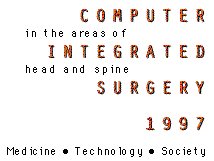

Computed Navigation in Cranio-Maxillo-Facial and Oral Head and Neck Surgery
Principles, Indications and Potentials for TelepresenceR.Ewers, M.Truppe*, A.Wagner, G.Enislidis, W.Millesi, F.Watzinger, F.Wanschitz
University Clinic for Maxillofacial and Oral Surgery, Vienna, Austria
*Artma Biomedical, Vienna, Austria
Practical Experience with the ARTMA Virtual Patient System in ENT Surgery
A.R.Gunkel, W.Freysinger, W.F.Thumfart
ENT Department, University of Innsbruck, Austria
Knowledge Guided ENT Surgery
(work in progress)M. Truppe*, A.R. Gunkel, W. Freysinger, W.F. Thumfart
*Artma Biomedical, Vienna, Austria
Clinic for ENT, University of Innsbruck, AustriaIn computer aided maxillofacial surgery we have shown the feasibility of telenavigation for a wide variety of indications [1, 2]. The superimposition of a guiding path with live video from the endoscope [3] during operation provides useful information even for the experienced surgeon. We have expanded our work [4] to visualize intraoperatively not only simple target structures in a CT but the knowledge of a remote expert.
At the local operating theater the patient is scanned in the CT with a special head frame in place prior to surgery. Also with the head frame in place an exploratory access to the endonasal cavity is recorded in the computer system as digital video sequence. All further steps of patient image coordinate transformation, simulation of an access path and intraoperative modifications of the simulation are performed at the remote expert location, thus dramatically reducing the complexity of the intraoperative manipulation.
Prior to surgery the CT data set and the digitally recorded video sequence is sent over a network (Internet) to the remote expert. 3D sensors are attached to the head frame and to the endoscope, this system is already calibrated in itself because the sensor position relative to the fiducial markers on the frame is constant. For the patient image coordinate transformation at the remote site only the fiducial markers on the CT are correlated with the corresponding markers on the head frame. The remote expert defines an access path to the endonasal cavity based on the CT data. This CT is visualized in two ways, as series of coronar slices and also as a volumetric 3D reconstruction of the anatomy by a real time rendering engine. This simulated path is sent back to the operating theater via the Internet as drawing parameters for the local computer. The surgeon has now available an intraoperative navigation without any manipulation necessary on his part.
During surgery the endoscopic live video and the stereotactic coordinates of the endoscope are sent via the network in real time to the remote expert. In addition to the video he can follow the the procedure by visualizing the position of the endoscope relative to the coronar slices of the patient. In addition the position of the endoscope relative to the patients anatomy is also visualized as projection of an overlay on the volumetric 3D CT reconstruction. Any proposed change of the access path is visualized by the remote expert relative to this 3D visualization first before sending it to the operating theater.
Discussion: Our new method makes it possible to perform all calibration and simulation steps at a remote site, thus shielding the surgeon completely from the complexity of the technology. Intraoperatively only the navigation path and the anatomically sensitive structures as defined by the remote expert are displayed. In contrast the remote expert can visualize the progress of the procedure also relative to a 3D volumetric rendering or other available medical imaging data of the patient. We see the initial potential of remote knowledge guided ENT surgery in training and education. At the CIS'97 we will show a live demonstration of this technology with a transmission from the University of Innsbruck.
Bibliography
[1]
W. Millesi, M. Truppe, F. Watzinger, A. Wagner, and R. Ewers, "Image Guided Surgery Extended by Remote Stereotactic Visualization," presented at CVRmed - MRCAS 97, Grenoble, 1997.
[2]
M. Truppe, "EURODOC (European Initiative for Remote Knowledge Visualization)," presented at CVRmed - MRCAS 97, Grenoble, 1997.
[3]
M. Truppe, "Process for imaging the interior of bodies," European Patent Office 1993, patent WO94/03100.
[4]
R. Gunkel, W. Freysinger, W. F. Thumfart, and M. Truppe, "Application of the ARTMA Image-Guided Navigation System to Endonasal Sinus," presented at Computer Assisted Radiology, Berlin, 1995.